We pick up where we left off in our last blog: in the heat of Jaen where, most importantly, we had managed to restock with a week’s supply of artisan coffee. So far, good coffee is much easier to find in Peru where a lot of the home grown beans seem to be consumed in-country (in contrast to Colombia, where all the good stuff is exported and the locals drink coffee so bad it has to be sweetened with industrial quantities of panela to make it drinkable). The route in this blog post takes us across the Rio Marañón (a major Amazon tributary), up the Utcubamba gorge, taking time to explore some of Northern Peru’s natural and archaeological wonders, before crossing back over the Marañón (much harder than it sounds) and heading towards Cajamarca, where we’ve now been resting up for a couple of days. This is an area that is often overlooked since there’s no bikepacking.com route, but acts as a great way of connecting the Trans Ecuador with the Peru Divide, serving up whole heap of contrasting landscapes and cultures in the process.
Still following our rise early and ride before the heat of the day strategy, we reluctantly obeyed the 5.30 alarm. On the dirt track out of Jaen, we passed a group of mountain bikers heading in the opposite direction – always a good sign that you’re in for a fun morning. Aside from a few fords across the rice irrigation canals, which required us to stop and remove our shoes and socks, the track flowed beautifully through the otherwise dry landscape.

We popped out on a broad river valley lined with sand and pebble shingle keeping our eyes open looking for the small ferry launch. Here the Rio Marañón is much smaller than expected; we even wondered whether we could just ford the river rather than taking the small ferry (which was two boats lashed together with a few planks of wood on top to make a platform). Clearly there hasn’t been much rain here for a while, as the width of the river channel indicates that at other times, it would be a site to behold. Once on the far bank and after a particularly bumpy section of dirt track, we treated ourselves to some coconuts in the shade, enjoying a moment of respite from the 40 degree heat.




A huge straight, rolling road delivered us to Bagua Grande for lunch, where we accidentally spent 50 soles on food (20 is our usual bill for a menu, the new term for a fixed price almuerzo). After lunch we spent a few hours in the shade, waiting for the hottest part of the day to pass as Liam picked the seals off his front hub bearings to discover shards of metal kicking about in there. At least the source of that popping noise has been identified! We decided that as we’d splurged a bit on lunch we should try and wild camp that night to average out our daily spend. This it turned out was a great idea as we climbed up to Laguna de Burlan for a swim and beer before pitching up for the night.
Reader, if tent chat bores you feel free to skip this paragraph. Our tent is ‘Tarp tent’ which is a style pitched with two hiking poles. Most bike tourers we’ve come across favour the free standing models which are easier to pitch without pegs e.g. on a hard surface. As it was warm we decided to pitch our tent inner only, forgoing the waterproof fly which makes hot weather camping much more stuffy. It requires a little bit of creativity with guy ropes to do this with ours but we manage… until half way through the night it started raining. So we had to quickly carry the tent under the cover of a nearby restaurant nearly losing a peg and Liam’s socks in the process. Liam tried to accuse some of the local dogs for running off with his socks before finding two pieces of biologically hazardous material sandwiched between the tent and the footprint.

Thanks to the rain the early start strategy lost out to a slow morning looking reluctantly out at the heavy rain, eventually it did ease and off we went in the direction of Pedro Ruiz. Riding together for most of the day listening to Michelle Obama’s ‘Becoming’ on my small speaker enjoying a behind the scenes account of her life before she became a public figure. Audiobooks while bike touring is a great way of devouring reading material. While stopped at some roadworks we met a group of Ecuadorean overlanders travelling by motorbike. A very friendly foursome from Quito, the oldest in their group was in his 80s! Their chats made the wait very enjoyable as we discussed routes, where everyone was from etc before they sped off up the hill and we trundled on in the heat. The day finished at 70km with 1400m, which is on the upper end of our average, and in the still sweltering heat. I was slowing towards the end when a small waterfall appeared at the side of the road and we both plunged our heads and feet in to try and bring our body temperatures back down. Bagua Grande seems like another of those ‘highway towns’ so while not the most picturesque has plenty of convenience, it also has a yoghurt shop which made up a tidy portion of our evening’s calorific consumption.
After researching what there was to see and do in the area we’d decided to take a day off the bikes to visit the Gocta waterfalls, depending on what school of arbitrary waterfall measuring you subscribe to these are either the highest or third highest waterfall in Peru. The waterfall is actually made up of two cascades so you can either measure the total height (771m which puts it as the fifth tallest in the world) or the height of the individual cascades. Pedantry waterfall measuring chat aside, they are a truly spectacular sight and despite being in full view from the nearest village and the other side of the canyon, they were only discovered by the outside world in 2002! We opted to stay in the small town of San Pablo and enjoy a longer walk to the falls instead of staying in the more touristy and overpriced town nearer the cascades.



Arriving in San Pablo was a lesson in ‘it’s better to know the name of your host than the name of the business/campsite you’re looking for’ as we searched around for Huala Lodge we were met by confused faces until Betty was finally located at the bottom of her coffee farm by a neighbour! The lodge was a small farm-stay with plenty of chickens and ducks, a simple campesino life! Betty was wonderful and fried up some fresh duck eggs to go with our lunch of rice and lentils. By now the weather was much cooler, with a view over the canyon and frequent showers to keep the ducks amused. The 15km walk to visit both cascades was much hillier and sporting than we perhaps expected so instead of a round trip we headed into Cochabamba for lunch and take a moto-taxi back. However, the rain had turned the road into a sticky yet traction-less mudbath. Hopping on and off his moto to push (in flip flops!) we wondered why the driver had never contemplated cyclocross.




When it was time to leave San Pablo the following morning we kept our fingers and toes crossed hoping the peanut butter mud would have dried enough to not clog our wheels and grant us easy passage back to the valley floor. Fortunately, the morning sun had done her job. Less fortunately, all the eccentric loading from walking downhill the day before had ruined my legs and I was hobbling like an old lady! Creaking along on my bicycle even more slowly than before! Our next destination was the town of Lamud to visit a collection of sarcophagi high up in the cliffs of the valley called the Pueblo de los Muertos. Unfortunately, rain struck again as we were on the dirt road out to the site and we were quite literally stopped in our tracks by the thick mud. Forced to camp at the side of the road we watched passing cars and motos struggle past on their way home as we made dinner.
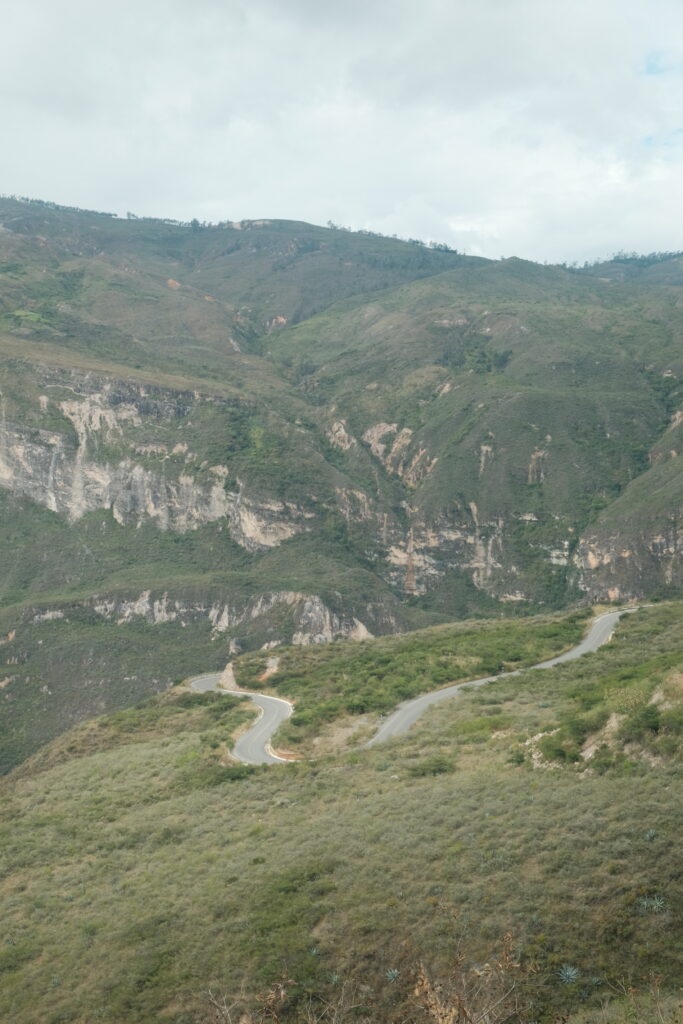


The mud gods were clearly at least partially on our side as we were able to make it to Pueblo de los Muertos in the morning. Having witnessed first hand the incredible sticking power of the mud it’s no wonder that these mausoleums and sarcophagi have survived for centuries despite clinging to the edge of cliffs high above the Utcucamba river . It is an absolutely insane site, with sarcophagi just sitting casually in these cliffs overlooking the abyss of the canyon. Still not recovered from the walk to Gocta and we decided to take an easy day and find accommodation in Lamud. We’d been going for around 11 days by this point (Gocta not counting as a rest day, just an off the bike day) and so we figured we needed to give ourselves a little recovery window if we were going to make it to our surf camp at the end of the month in one piece. Lamud is a beautifully kept town and we enjoyed wandering the streets and eating ice creams in the square, enjoying having the time to properly take in our surroundings.




From Lamud we turned off the Chachapoyas road and followed a beautiful turquoise river upstream for the next day and a half. It was the stuff cycle touring dreams are made of with little traffic, a gentle flowing road lined with trees and lots of swimming opportunities. The biggest archaeological site in the whole Amazonas area Kuelap, is famously closed having suffered a lot of damage which caused some of the walls to collapse. It is still possible to take the cable car to see the site from afar, so we climbed up to Nuevo Tingo for lunch but didn’t see much cable car action and starting to worry we’d not carried enough cash for the next few days descended back to our favourite river lined road to continue riding towards Leymebamba.



The month of July seems to be a month of celebration (and possibly protests towards the end of the month) and as we entered Leymebamba there was music blaring and plenty of plastic bunting fluttering in the wind. The town is famous for it’s museum which is home to around 200 mummies and funerary offerings discovered at the nearby Laguna de los Condores in 1997. The whole community was involved in building the museum contributing both matierals and labour, and they still run and own the place today. The exhibits are a mix of Chachapoyan and Chachapoyan-Incan from musical instruments to skeletons and everything in between. The Chachapoyans were described as tall, fair-haired people with the women being particularly known for their beauty. I find it so interesting that following the Spanish invasion the mixed race Andean people are dark haired and short, but clearly the indigenous ancestors were quite phenotypically distinct. The following image block does show human and animal remains so scroll past quickly if you’re squeamish!











We found a lovely camp spot above Leymebamba tucked away by the side of a river but woke up to a frosty tent and Liam was wrapped in his big down jacket as he cooked porridge waiting for the sun to reach us. We’d later descend into 40 degree heat!

The next two days were spent climbing up over the Calla Calla pass at 3,600m, descending down 60km to 800m above sea level, cross back over the Marañón and climb some 2,300m back up the other side of the canyon. It’s hard to quite capture the scale of this place even with numbers like that! The road is now tarmac but it was still gravel when Cass Gilbert came through in 2012.


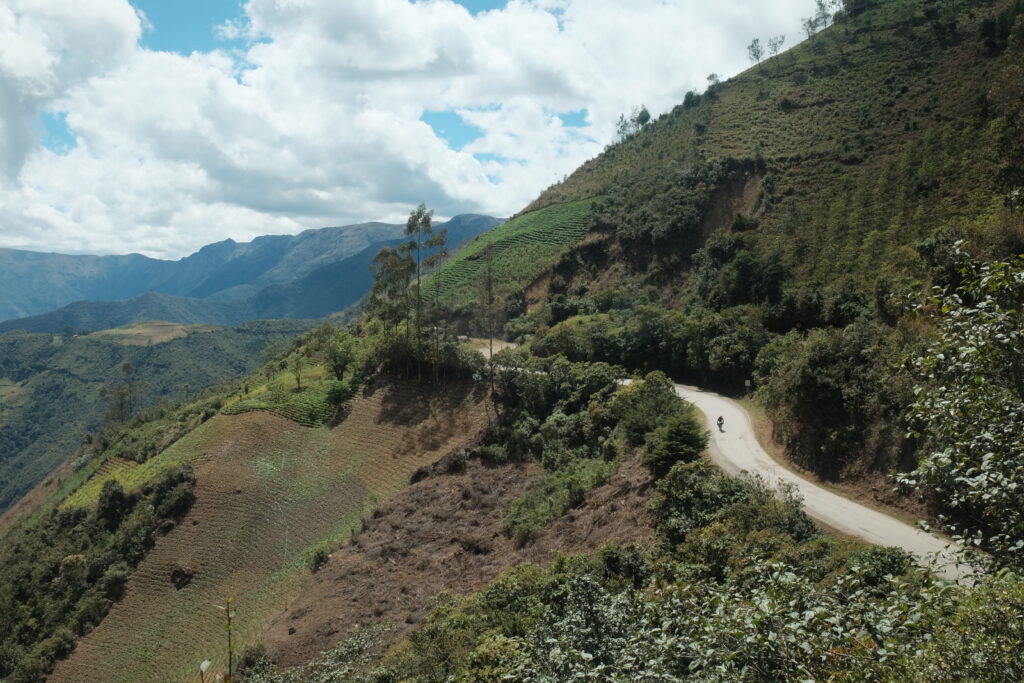







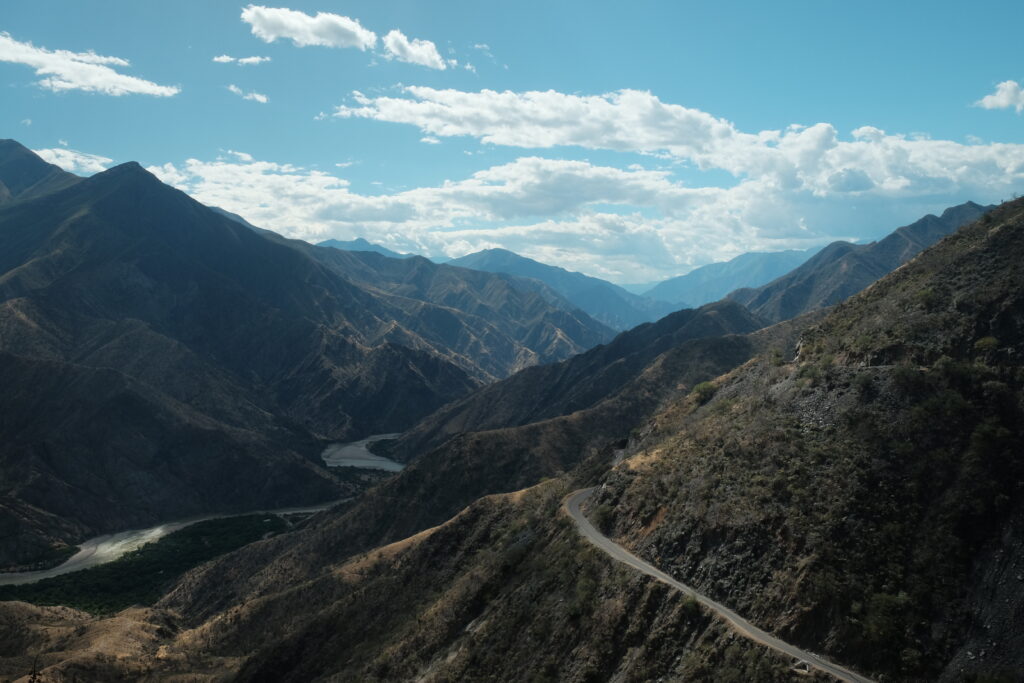
The downside of the climb back up the canyon, aside from having to climb from 800m to 3,100m, was that there wasn’t much by the way of food options. Liam got quite hangry when he realised we only had one packet of crackers left and that they would need to be rationed! Exhausted and empty we finally made it and treated ourselves to two bowls of a local delicacy at the top, cheese and honey! Life in the Andes is hard but that does mean that their diet is equally energy dense for cycling.




Descending down into the city of Celendin on the other side we were ready for a lie down and a shower so checked in at the Hospedaje Mi Posada where the owner loves to welcome overland travellers and show them photos of all the folks of different nationalities which have come through. The town was warming up for a religious festival and in the evening the town was gathered in the main square for a firework display. A bamboo tower had been constructed with various spinning arms and shapes propelled by rockets which were lit by a man wearing a high vis jacket and igniting the fuses with his cigarette.

We took some back roads towards Cajamarca splitting this final stage at Polloc with a wild camp at the edge of town and a quick detour to see the mosaics of the Church. The final descent into Cajamarca got busier as we neared the town. We’ve been here for a few days running errands, replacing wheel bearings, eating cheese, sipping pisco sours and enjoying the many markets of the town (you can’t beat 7sol cervice!). It’s beautiful but unlike Cuenca where we felt transported back to Europe the city still feels very South American. From here we will deviate slightly from the traditional Andean bike tour as we head towards the coast to hopefully surf the world’s longest left-handed wave.





Routes
If you’re interested in our routes, you can find them all on our trip homepage.
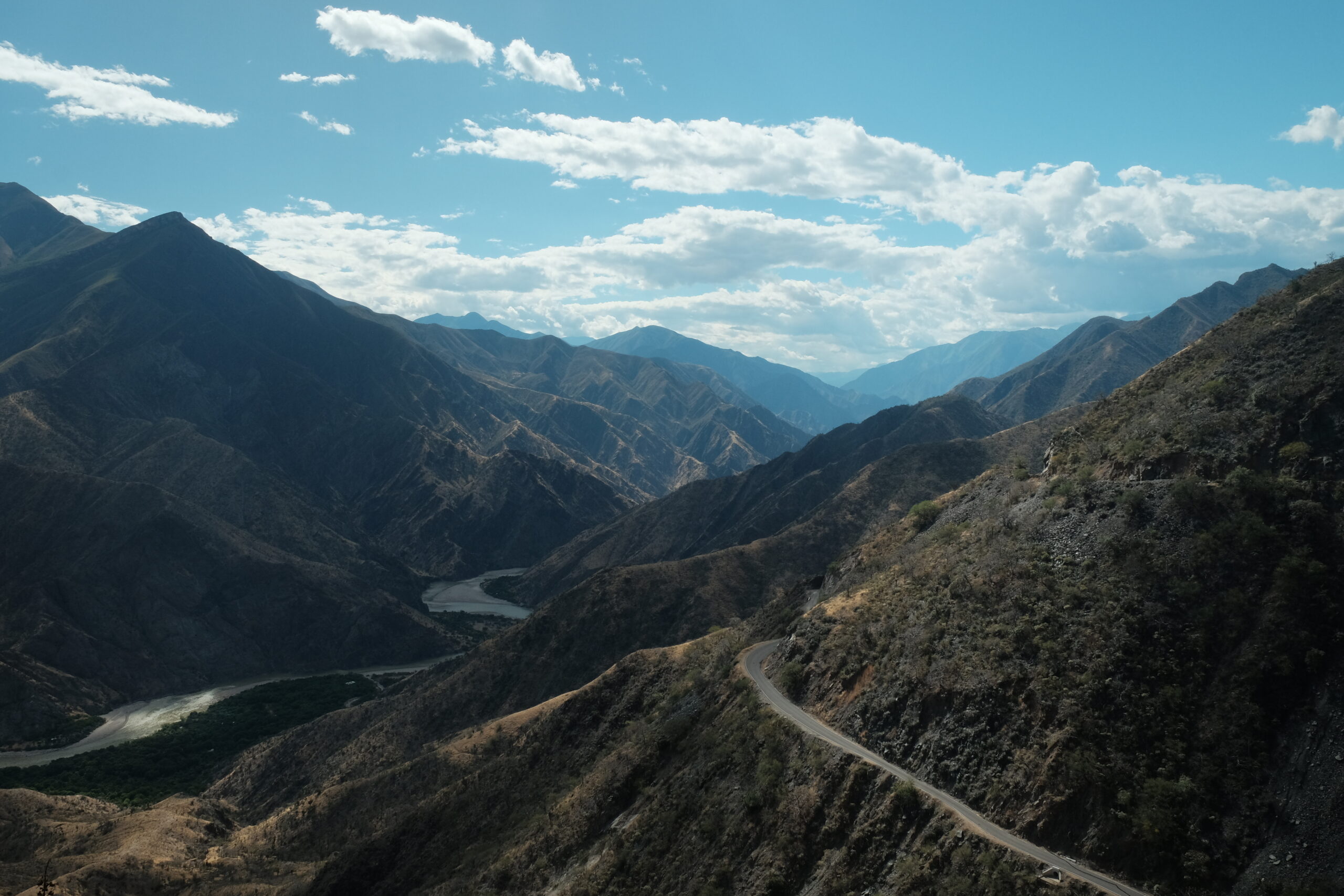
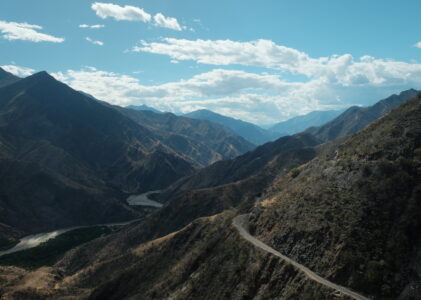
Pingback: Buenas Piernas! - drawinglinesonmaps.com